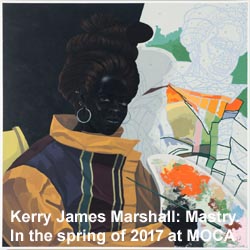| It’s good to see that the fashion industry isn’t just full of money-driven, well-dressed people. The Collezione Maramotti Museum is an example of how the fashion industry can interact with the art world, and give back to the community. Set in the outskirts of Reggio Emilia (kind of the middle of nowhere, yet the heart of Italian fashion) the museum, built in 1957 to house Achille Maramotti’s Max Mara factory, was turned upside down to become an art space by British architect Andrew Hapgood in 2003, and the collection was born. The space is full of trans-avant-garde paintings, Schnabel, Salle, and so on, yet there are some masterpieces in there: a massive flying canoe installation by Claudio Parmiggiani titled Caspar David Friedrich from 1989. |  |
Stefano Pasquini
It’s good to see that the fashion industry isn’t just full of money-driven, well-dressed people. The Collezione Maramotti Museum is an example of how the fashion industry can interact with the art world, and give back to the community. Set in the outskirts of Reggio Emilia (kind of the middle of nowhere, yet the heart of Italian fashion) the museum, built in 1957 to house Achille Maramotti’s Max Mara factory, was turned upside down to become an art space by British architect Andrew Hapgood in 2003, and the collection was born. The space is full of trans-avant-garde paintings, Schnabel, Salle, and so on, yet there are some masterpieces in there: a massive flying canoe installation by Claudio Parmiggiani titled Caspar David Friedrich from 1989. Its imposing size and blackness float over our head in a totally white cube; it seems you’re suddenly transported into the sequel of 2001: A Space Odyssey, and you’re left wondering where it’s going to end.
A beautiful Basquiat reminds one of what painting means; some interesting Tom Sachs are there to intrigue viewers, and a portrait of Matthew Barney by Barry X Ball takes one back to this decade in diverted somberness. The top piece is from 1978. Vito Acconci installed it in a hotel in Bologna, a sound and wood installation titled Two or three structures that engage to a room in order to sustain a political boomerang (roughly translated), and it’s a preview of Acconci’s future architectural works. As viewers enter this modified space, light bulbs turn on and off, and his raucous voice takes them back in time. Even the original hotel space was rebuilt in the collection to preserve the original installation, presented by the Bolognese gallery Mario Diacono.
This eclectic huge collection also houses a project space, where a small retrospective of software artist John F. Simon, Jr. was inaugurated. I hadn’t known his work, and I found some of his works intriguing, especially his early Apple Mac applications, studied to produce endless abstract patterns that never repeat themselves. One would have to stare at them for like 20 hours in order to make sure there’s no repeating pattern. I found of less interest the newest works, where the software monitors are framed by some kitsch painted pattern reminiscent of what’s inside the work, yet I couldn’t help but think that it could have worked better in a plainer presentation.
At a time in Italy where contemporary art museums shut down, more for lack of interest than for lack of funds, it’s good to see museums such as the Collezione Maramotti flourish and showcase new work.



















